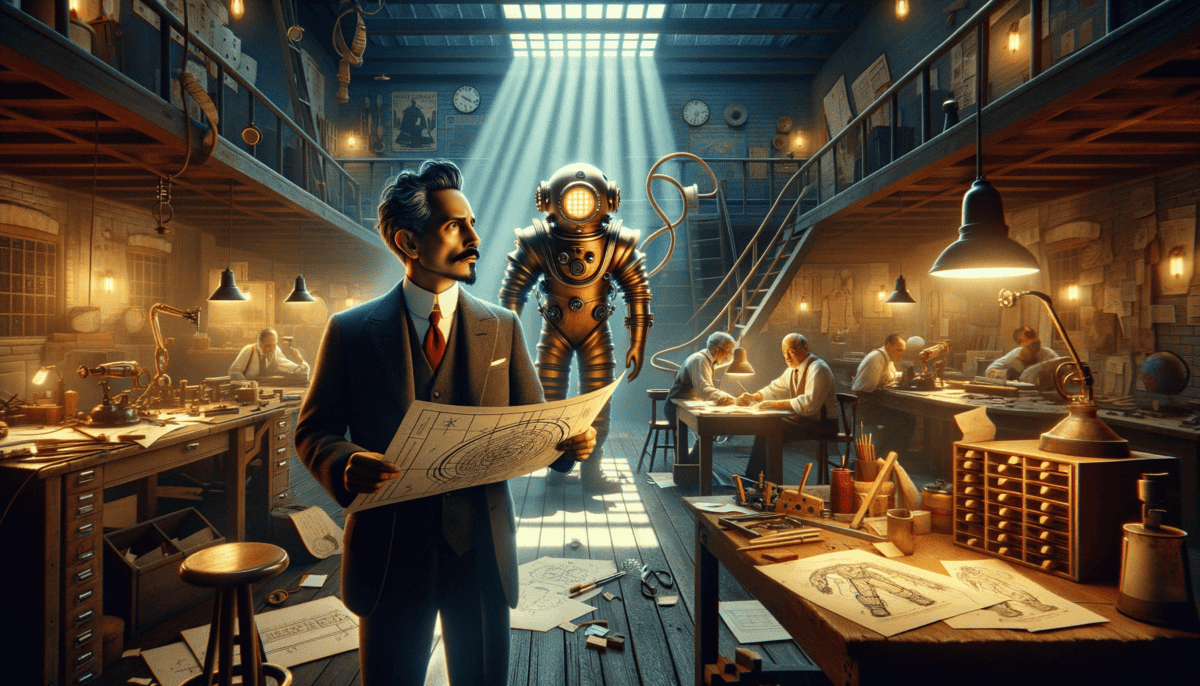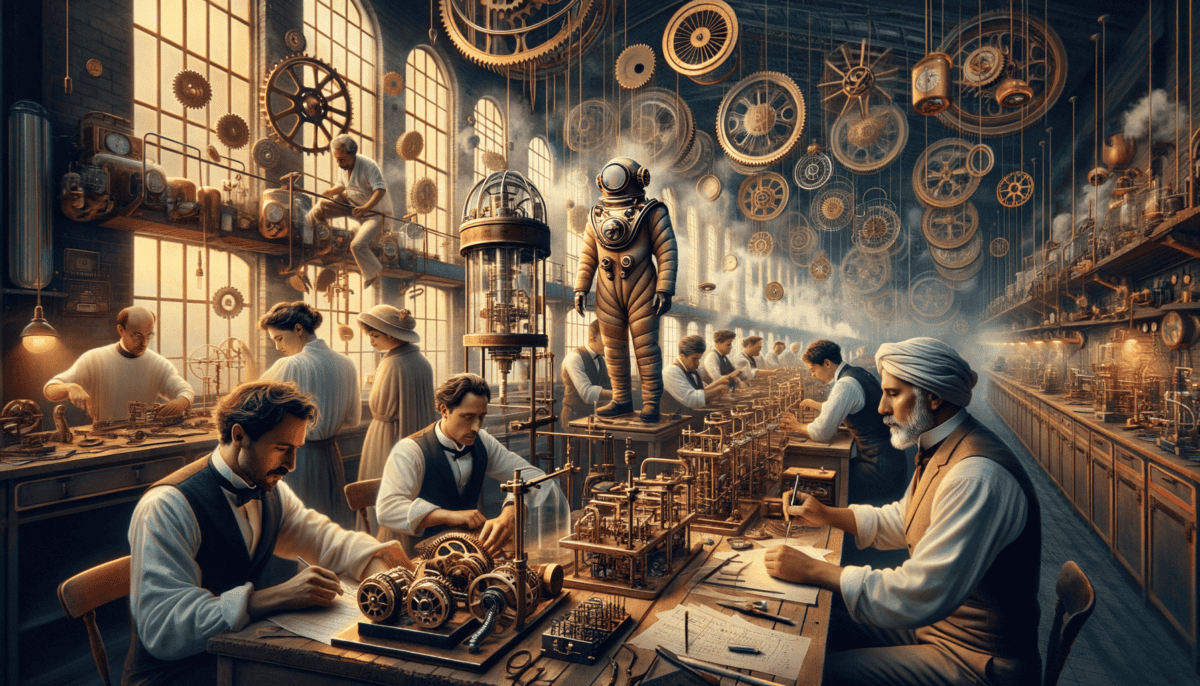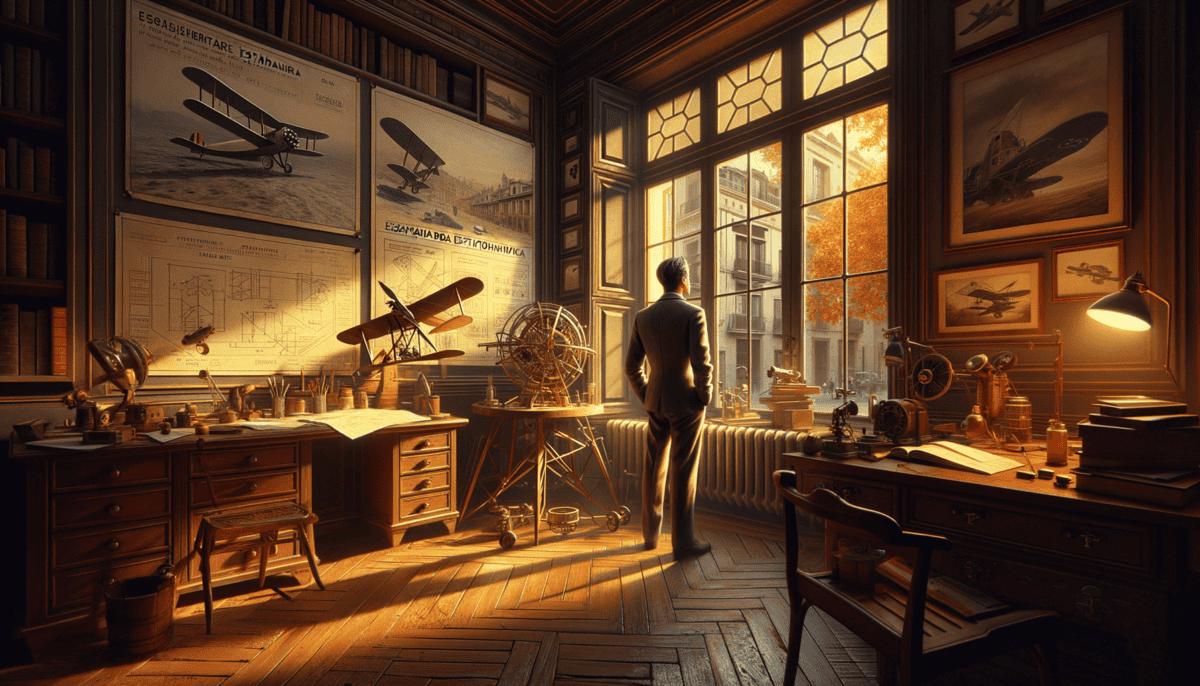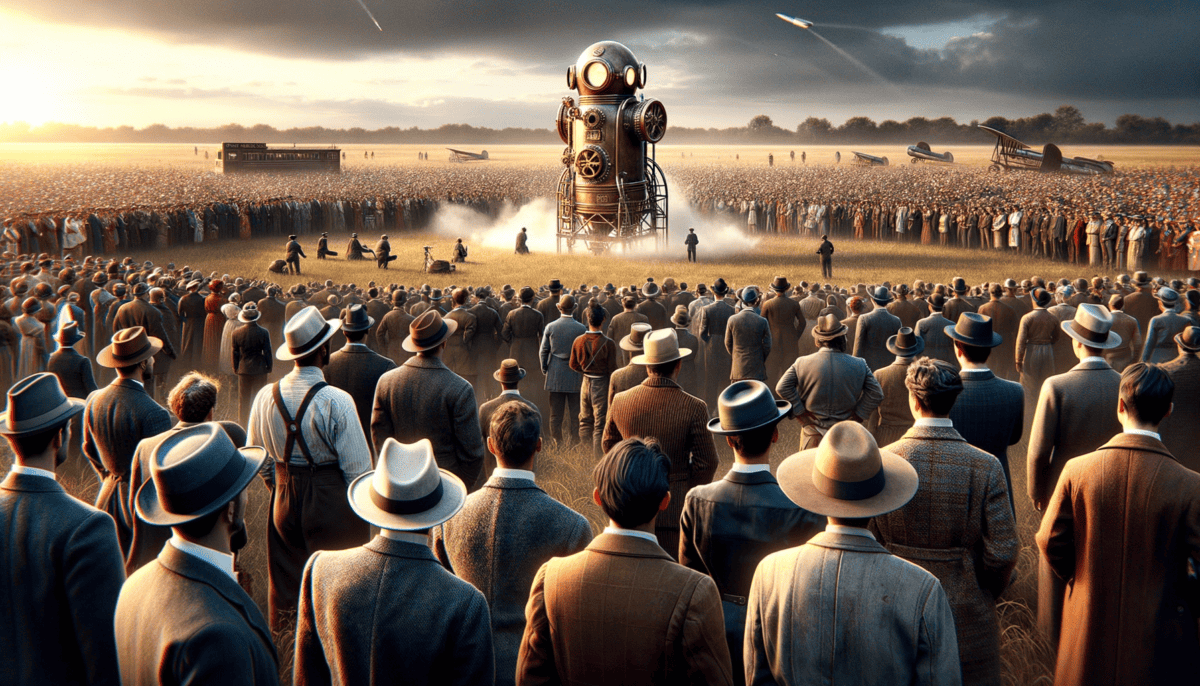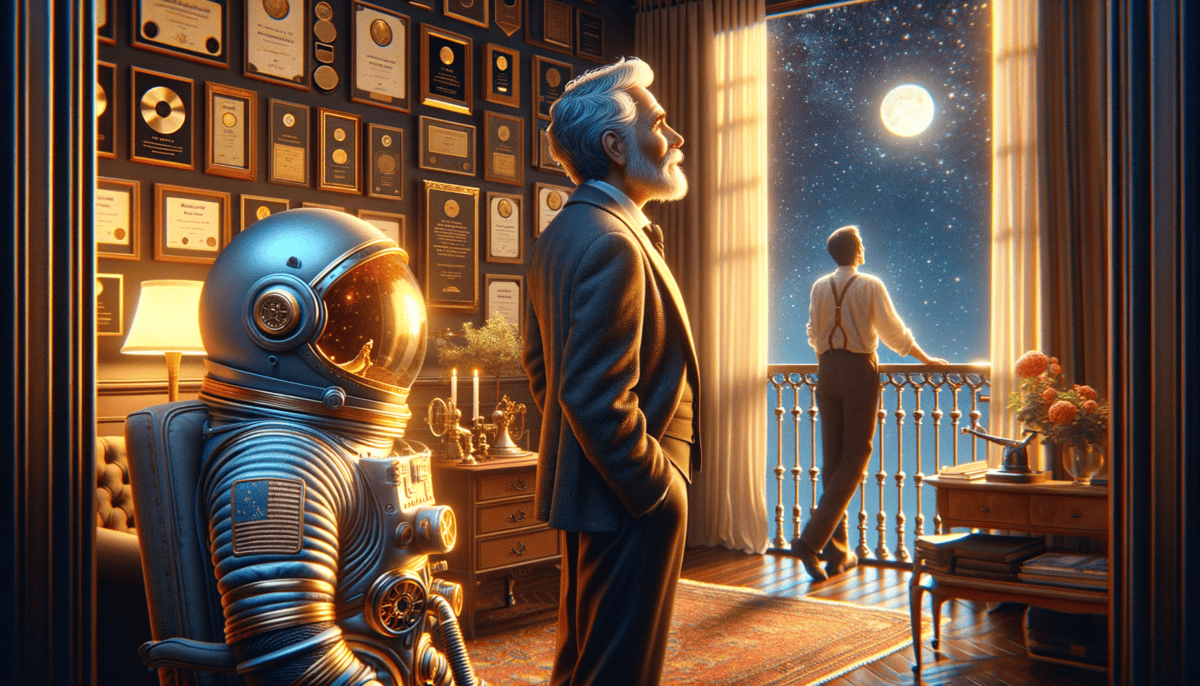Dreams of the Sky
The warm Spanish sun filtered through young Emilio's window as he pressed his nose against the glass, watching a hot air balloon drift lazily across the Granada sky. It was 1880, and the eight-year-old boy's eyes sparkled with wonder.
"Mamá! Look at the balloon!" he called out excitedly. "It's like a giant floating pearl!"
His mother smiled warmly as she joined him at the window. "That's the spirit of discovery you're seeing, mi amor. Just like the brave explorers who reach for the stars."
Little Emilio couldn't tear his eyes away from the magnificent sight. But something tugged at his young heart – a story he had heard just yesterday about a balloonist who never came home.
Why do some explorers never return? he wondered.
In his cozy bedroom that evening, surrounded by drawings of flying machines, Emilio made an important decision. "I will help keep the sky explorers safe," he whispered to himself.
Each morning, Emilio would rush to school with his notebook full of airplane sketches. His teacher, Señor Martinez, noticed the young boy's passion.
"Tell me, Emilio, why do you draw so many flying machines?" Señor Martinez asked one day.
Emilio's response came without hesitation: "I want to help people touch the sky without getting hurt!"
His classmates giggled, but Señor Martinez nodded thoughtfully. "Then you must learn everything you can about air and science."
The young boy took these words to heart. He spent hours reading about:
• How birds fly
• What makes balloons float
• Why the air gets colder up high
• How clouds form in the sky
• What happens when people go very high up
"Did you know," Emilio told his little sister one evening, "that it gets very, very cold up in the sky? And there's less air to breathe too!"
As he grew, so did his understanding. He learned about the brave men who tried to reach the highest parts of our atmosphere – the stratosphere. Some never returned, and this made Emilio's heart heavy but determined.
One night, as stars twinkled above Granada, Emilio had a dream. He saw himself creating a special suit – like armor for sky explorers. In his dream, the suit kept them warm and safe, letting them breathe easily even where the air was thin.
When he woke up, he grabbed his pencil and started drawing. This wasn't just another sketch – it was the beginning of what would one day become the Escafandra Estratonáutica, though young Emilio didn't know it yet.
His father found him surrounded by papers covered in drawings. "What are you making, hijo?"
"A suit to protect people who fly very high," Emilio replied, his pencil moving quickly across the paper. "Like a knight's armor, but for the sky!"
His father ruffled his hair affectionately. "You have the heart of an inventor, Emilio. Never lose that."
That night, as the moon cast soft shadows in his room, Emilio added his newest drawing to his growing collection. He didn't yet know about pressure systems or oxygen supplies, but he knew in his heart that someday, he would help make the sky a safer place for explorers.
The stars seemed to twinkle a bit brighter that night, as if they too were excited about the dreams of a young boy who would one day help humans reach closer to them safely.
"Buenas noches," Emilio whispered to the sky, his mind already filling with new ideas for tomorrow's adventures in learning and inventing.
The Engineering Challenge
Years had passed, and Emilio Herrera now stood in his workshop at the Military Engineering Academy in Madrid. The year was 1932, and his childhood dreams had grown into something bigger.
“The air up there is different,” Emilio explained to his colleague, pointing to his calculations. “It’s not just about the cold – it’s about pressure.”
His desk was covered with weather reports and drawings. Each morning, he studied them carefully while sipping his café con leche. The numbers told a scary story:
• At 60,000 feet:
- Temperature drops to -70°F
- Air pressure is barely there
- Normal clothes won't help
- Regular oxygen masks fail
- Water in the body can boil
Many scientists thought it was impossible to solve these problems. “You’re chasing fairy tales, Herrera,” they would say. But Emilio remembered his childhood promise.
“What if we create a suit that’s like a tiny airplane?” he said one day, sketching rapidly. “It needs to be its own little world!”
His young assistant, Miguel, looked confused. “Like a tiny airplane? How?”
Emilio grabbed a balloon and a glass jar. “Watch this,” he said with a smile. He put the balloon in the jar and started pumping out the air. The balloon grew bigger and bigger.
“See? Without pressure outside, things want to expand. Our bodies would do the same thing up high. We need to create pressure around the person, just like they’re still on the ground.”
He worked day and night, making detailed plans for his special suit. He called it the Escafandra Estratonáutica – the Stratospheric Diving Suit.
Some days were harder than others. “It’s not working!” he would exclaim, crumpling up another failed design. But then he’d remember the lost balloonists from his childhood stories and start again.
His wife would bring him dinner in the workshop. “Mi amor,” she’d say, “you need to rest.”
“Just one more try,” he’d answer, already reaching for his tools.
The biggest challenge was making the suit flexible enough to move in, but strong enough to hold pressure. Emilio tried different materials:
First try: Regular fabric – too weak
Second try: Thick rubber – too stiff
Third try: Special layered material – getting closer!
One evening, while testing a new joint design, Emilio had a breakthrough. “The joints need to be like accordions!” he exclaimed. “They can bend while staying strong!”
He rushed to draw his new idea. The suit would have special bendable parts at the knees, elbows, and waist. Metal rings would hold the pressure, while soft sections would let the person move.
“Don’t you see?” he explained to his doubtful colleagues. “It’s like wearing a tiny greenhouse! The person inside stays safe, warm, and can breathe normally!”
Some people laughed at his ideas. Others said it was impossible. But Emilio kept working. He remembered what his father had told him long ago about having an inventor’s heart.
Late one night, as he finished another set of calculations, he smiled at a photo of that first hot air balloon he’d seen as a child. “We’re getting closer,” he whispered. “Soon, we’ll touch the stars safely.”
The workshop lights burned late into the night as Emilio continued his work, each small success bringing him closer to his dream of protecting those who dared to explore the sky.
Dreams Take Shape
The summer of 1933 brought exciting changes to Emilio’s workshop. The walls were now covered with detailed drawings of his stratospheric suit, and the sound of hammering filled the air. ️
“Pass me that measuring tape, Miguel,” Emilio called out, standing next to a half-finished metal frame. The suit was starting to look real!
“Look at this!” Emilio demonstrated, bending the knee joint back and forth. “It moves like a real leg, but keeps all the air inside.”
His team had grown. Now five people worked with him, each bringing special skills:
- Carmen – expert in strong fabrics
- Miguel – helped build the parts
- Rosa – checked all the air systems
- Juan – made the metal pieces
- Pablo – tested everything for safety
One morning, Carmen rushed in with exciting news. “I found it!” she exclaimed, holding up a shiny piece of fabric. “This material can handle both the cold and the pressure!”
Emilio’s eyes lit up. He had been waiting for this moment. “Quick, let’s test it!” They carefully cut the fabric and added it to their latest prototype.
“Remember,” Emilio told his team, “this suit needs to be like a tiny house. It keeps the good air in and the bad air out.”
They worked on many important parts:
The Helmet: Clear like a bubble, so pilots could see everything
The Air System: Clean air went in, bad air went out
The Joints: Bent easily but stayed strong
The Gloves: Thin enough to feel things, but tough enough to protect
Some days brought big problems. One morning, the test helmet cracked during a pressure check.
“Don’t worry,” Emilio said, patting Miguel’s shoulder. “Each mistake teaches us something new.”
They tried again, making the helmet stronger. This time it worked perfectly!
Rosa had a clever idea for the breathing system. “What if we add a backup air supply?” she suggested. “Just in case the main one has trouble?”
“¡Brillante!” Emilio clapped. “Safety first, always!”
The suit was getting better every day. They added:
Special heating wires to keep warm
Radio system to talk to ground crews
Emergency signals if help was needed
One afternoon, Pablo tried on the newest version. “It feels like wearing a friendly robot!” he laughed, walking around the workshop.
“How many steps to put it on?” Juan asked, taking notes.
“Good question!” Emilio grabbed his notebook. “Let’s make it simple. Pilots need to get dressed quickly.”
They worked out an easy way to put on the suit:
“First the soft inner layer,
Then the strong outer shell,
Connect the air lines carefully,
Check everything works well!”
At the end of each day, Emilio would walk around his creation, checking every seam and connection. He imagined brave pilots wearing his suit, floating safely in the stratosphere.
“Soon,” he whispered to the suit one evening, “you’ll help people touch the sky.”
The workshop lights dimmed, but the dream grew brighter. Tomorrow would bring new challenges, but Emilio and his team were ready. Their special suit was almost ready to meet the stars.
Dark Clouds Gather
The warm spring of 1936 changed everything. Emilio stood at his workshop window, watching storm clouds gather over Madrid. But these weren’t ordinary clouds – they were the clouds of war. ️
“We need to pack up the important things,” Emilio told his team quietly. “The civil war is coming.”
“But what about the suit?” Carmen asked, touching the shiny fabric they had worked so hard to perfect.
Emilio’s heart felt heavy. His beautiful suit, the Escafandra Estratonáutica, sat half-finished on its stand. It looked like a lonely astronaut waiting for its mission.
“We can’t stop now,” Rosa said firmly. “This suit isn’t just for Spain – it’s for everyone who dreams of exploring the sky!”
But finishing their work got harder each day:
- Materials became scarce
- Money for research disappeared
- Many team members had to leave
- The workshop wasn’t safe anymore
- Other countries offered help, but from far away
One rainy morning, Miguel arrived with serious news. “The government wants to use our workshop for the war effort,” he said softly.
Emilio looked at his precious invention. “Then we’ll work faster,” he declared. “And we’ll save what matters most.”
They created a special code to protect their designs:
Blue Bird: The helmet system
Dancing Bear: The joint mechanisms
Singing Fish: The air supply
Some good news arrived from France!
“French scientists want to help us,” Emilio announced, waving a letter. “They understand how important this work is.”
But leaving Spain meant leaving part of their dream behind. Emilio spent one last night in his workshop, remembering:
The first successful pressure test
The joy of each small victory
The sound of his team laughing
The hope of touching the stars
As dawn broke, Emilio made his decision. “We’ll take the most important parts and the designs,” he told his team. “And we’ll continue our work wherever we can.”
Carmen wiped away tears as they carefully packed their precious invention. “The suit will fly someday,” she promised.
Juan helped create special boxes that looked ordinary outside but kept their treasures safe inside. Pablo marked them with innocent labels like “Old Books” and “Kitchen Things.”
Before they left, Emilio wrote in his diary:
As they closed the workshop door, Rosa squeezed Emilio’s hand. “This isn’t the end,” she whispered. “It’s just a different path to the same stars.”
That night, as Emilio prepared to leave his beloved Spain, he looked up at the dark sky. Somewhere up there, beyond the clouds and the chaos, the stratosphere waited patiently for his suit. And he would find a way to finish what they started, no matter what storms came their way. ⭐
Reaching for the Stars
The morning sun peeked through the windows of their new workshop in France. Emilio stood before the reassembled Escafandra Estratonáutica, his heart racing with excitement. Today was testing day!
“Are you ready?” Carmen asked, checking the suit’s pressure gauges one last time.
“I’ve been ready my whole life,” Emilio replied with a smile that couldn’t hide his nervousness.
The French scientists gathered around, their notebooks ready. Dr. Pierre, their lead host, stepped forward:
• Check every seal twice
• Keep medical help nearby
• Test in small steps
• Watch all gauges carefully
• Have backup air ready
Rosa helped Emilio into the suit, her hands steady but her voice shaking. “Remember what we practiced,” she whispered.
The helmet clicked into place with a soft whoosh. Inside, Emilio could hear his own breathing echo. The suit felt like a second skin, just as they had hoped!
“Communications check,” Miguel called through the radio.
“Clear as a bell,” Emilio responded, giving a thumbs up.
Dr. Pierre began the pressure test sequence:
“Starting at normal pressure…”
“Now increasing to 5,000 feet…”
“10,000 feet…”
“15,000 feet…”
Inside the suit, Emilio felt perfectly comfortable. Their design was working! The special joints moved smoothly as he walked around the test chamber.
“It feels like I’m walking on clouds!” he exclaimed through the radio, making everyone laugh.
But then came a scary moment. At 30,000 feet pressure, a small warning light blinked on Carmen’s control panel.
“Seal check on the left knee!” she called out quickly.
The whole room held their breath. Emilio stayed completely still while Rosa examined the joint.
“All clear!” she announced, and everyone cheered.
They continued the test, pushing higher:
35,000 feet – Perfect
40,000 feet – Stable
45,000 feet – Strong
50,000 feet – Success!
When they finally helped Emilio out of the suit, his face shone with joy. “It works!” he exclaimed, hugging each team member. “It really works!”
Dr. Pierre shook Emilio’s hand warmly. “You’ve done something amazing here,” he said. “This suit could change everything about high-altitude exploration.”
That evening, the team celebrated in their favorite café. Miguel raised his glass:
“To dreams that fly high, and to friends who help them soar!”
Back in the workshop, Emilio sat alone with the suit. He touched its gleaming surface gently, remembering the long journey from first sketch to this moment.
The stars twinkled through the workshop window, seeming closer than ever before. Tomorrow they would test even higher pressures, but tonight, Emilio simply smiled at his dream come true. The impossible had become possible, one careful step at a time. ⭐
Legacy of Dreams
Paris sparkled in the morning light as Emilio walked through the garden of the French Academy of Sciences. Today, he would present the Escafandra Estratonáutica to the world’s top scientists.
“Look at all these people!” Carmen whispered, peeking through the auditorium doors. Scientists from across Europe filled every seat.
“Who would have thought our little dream would bring us here?” Emilio smiled, adjusting his tie.
The suit stood proudly on stage, gleaming under the lights. Rosa had polished every inch until it shone like a star. Dr. Pierre stepped up to the microphone:
Emilio’s heart raced as he shared their story. He told them about watching balloons as a boy, about the friends they’d lost to the dangerous heights, and about the team that never gave up.
• Works up to 80,000 feet
• Keeps astronauts safe
• Moves easily like regular clothes
• Has special cooling system
• Can talk through radio
When he finished speaking, the room fell silent. Then one scientist stood up and started clapping. Soon, the whole room thundered with applause!
After the presentation, a young American scientist rushed up to shake Emilio’s hand.
“This is incredible!” he exclaimed. “We’re designing spacesuits at NASA, and your ideas could help us reach the moon!”
That evening, the team gathered in their workshop one last time. Miguel hung a special frame on the wall – their very first sketch of the suit, drawn years ago on a café napkin.
Carmen touched the frame gently. “Remember when people said it was impossible?”
Rosa laughed. “Now they’re talking about using our design to walk on the moon!”
Years later, when the first astronauts walked on the moon, their spacesuits used many ideas from Emilio’s design. His dream of keeping explorers safe had reached all the way to the stars!
One sunny afternoon, an older Emilio visited a school in Madrid. A little girl raised her hand:
“Were you scared when people said you couldn’t do it?”
Emilio smiled warmly. “Sometimes. But here’s what I learned – big dreams need three things: good friends, hard work, and most importantly, the courage to believe in yourself.”
“The stars are waiting for dreamers like you,” he told the children. “Never stop reaching for them!”
Today, space museums around the world display the Escafandra Estratonáutica. It reminds us that one person’s dream can change the future for everyone. Emilio’s suit didn’t just protect explorers – it showed us that with friendship, courage, and determination, nothing is truly impossible. ⭐
And somewhere up there, high above the clouds where Emilio’s journey began, astronauts still soar safely through the stars, carrying his legacy with them into the endless blue beyond.


